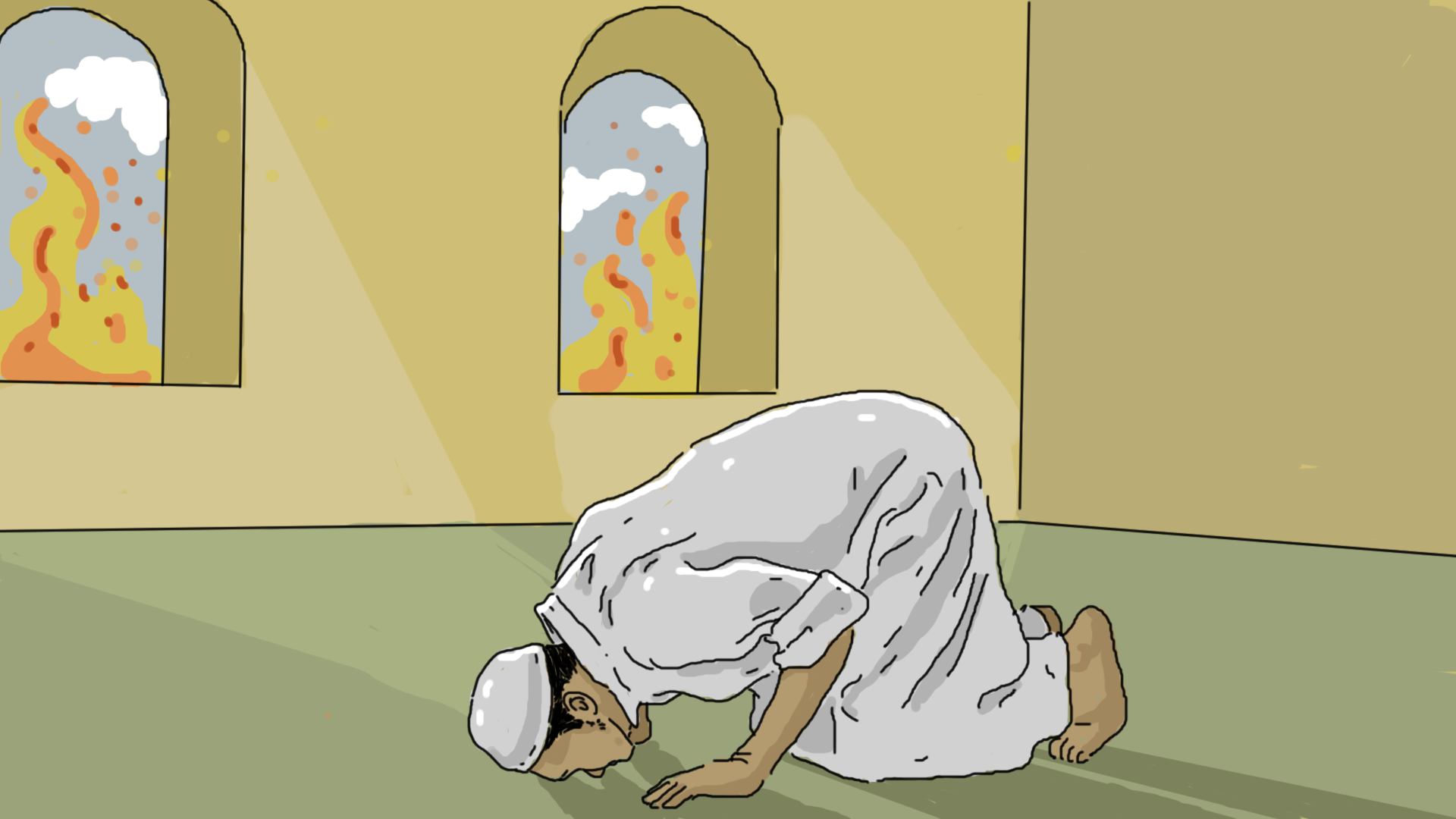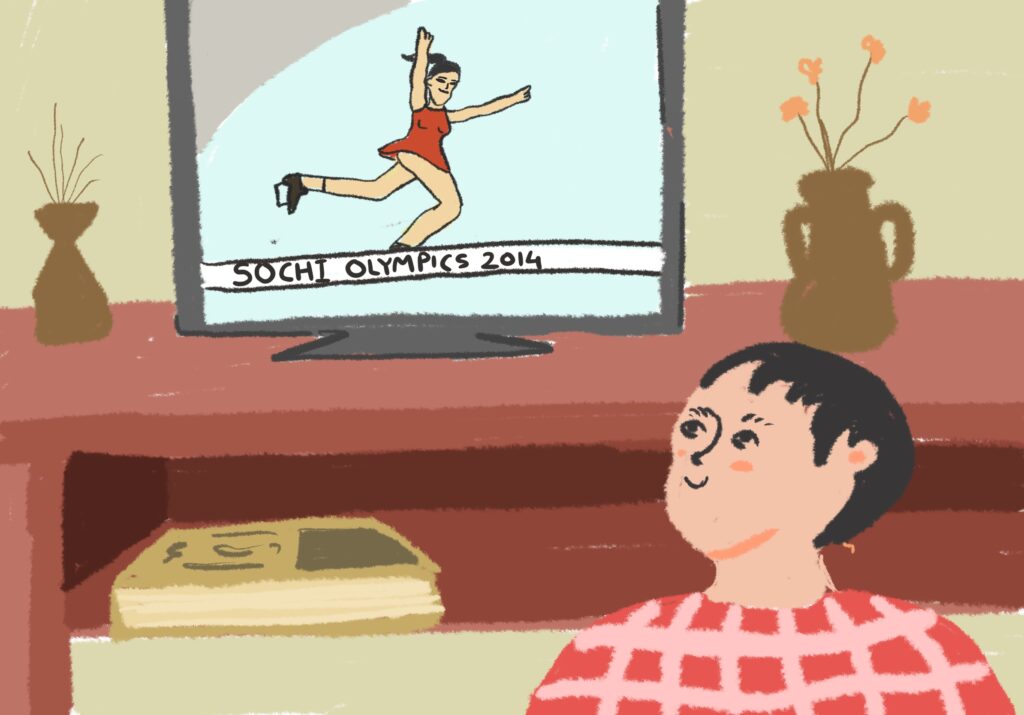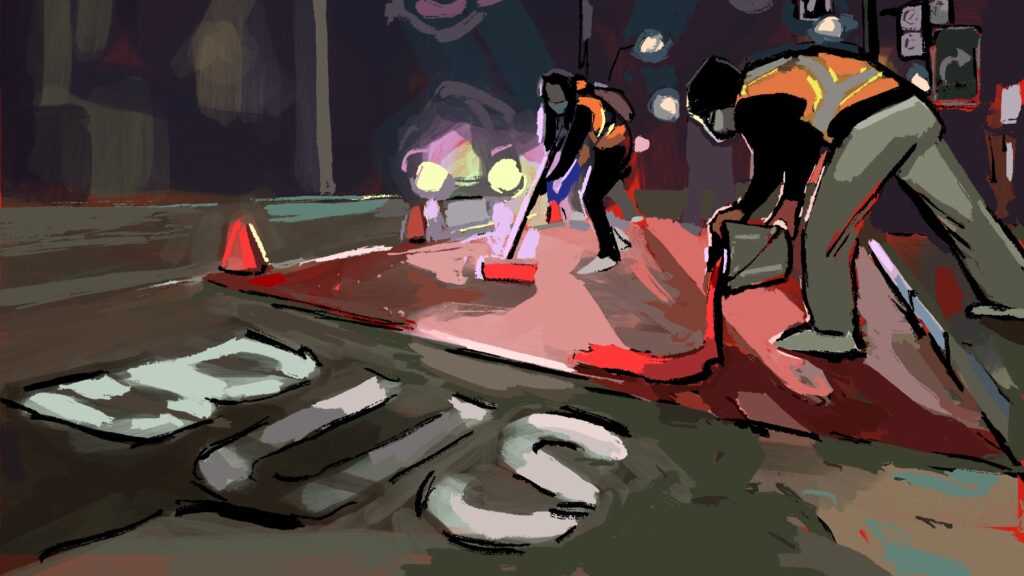When government institutions are the oppressors, who delivers justice?
BY DANIYAH YAQOOB
ART BY JOSHUA BEN JOSEPH
———————————————————–
* The names of some sources in this story were changed due to concerns about personal safety. Their identities have been verified by The Otter.
In his gated neighbourhood community in western Pakistan, Ali tried to befriend the other boys. They played under the blazing sun, where the air was fresh, the grass unkempt, and time seemed to pass by all too quickly before their mothers called them home. There was an unspoken trust among the parents to let their children play outdoors, most of whom were co-workers at the local sugar mill. Ali’s dad worked there, too, but his parents would not let him spend time with the neighbourhood boys. Instead, he’d listen to the sounds of hockey sticks striking the local field, the crack of the cricket bat when it hit a sixer, and the shouts of the kids who played outside his window—too far to be part of it, but close enough to long for the experience.
One afternoon in 2007, Ali’s older brother agreed to take him outside. Finally, he would get to be a neighbourhood kid and play on the street that lined the front of their homes. But the boys did not intend to play with Ali. Instead, for reasons unbeknownst to him at the time, they got into a spontaneous fight with his brother. The children picked up small stones in the middle of the argument, but these were not tokens for some new game. They were for throwing.
The sky was blue that day, a bright backdrop to the rocks showering down towards Ali. They crossed the length of the mud street he’d hoped to play on until they found their marks: two hit Ali, causing enough pain that he can still recall it years later. Another two struck his brother. He remembers running in his brother’s protective shadow back to their house and into his mother’s embrace, familiar arms that provided him shelter. His mother pulled the end of her dupatta, a long, patterned fabric draped over her chest in a shawl-like fashion, and blew hot air onto the cloth— the Pakistani mother’s remedy for every injury. Tenderly, she pressed it to his already-swelling wounds.
That day, four-year-old Ali faced his first act of aggression at the hands of young children. At the time, he didn’t know what it meant or why he had been their target. Soon, he would find out: His religious identity made him different. And there would be many more attacks to come.
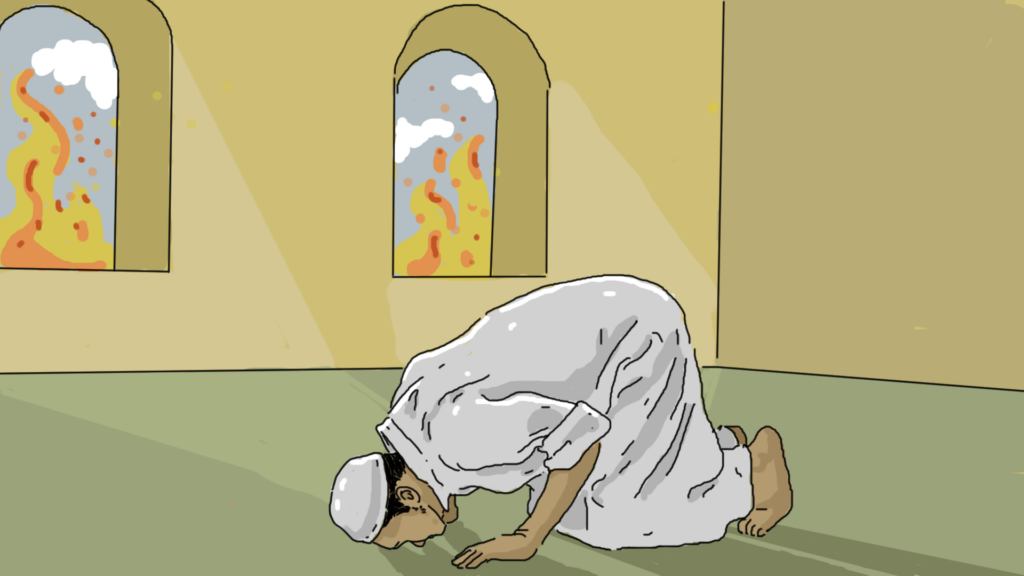
The Revival Movement
The Ahmadiyya Muslim Jama’at (AMJ) is a faith group recognized as a revival movement within Islam. With tens of millions of members worldwide, it represents the seventy-third sect (or branch) of the religion, with each faction reflecting a divergence in the interpretation of Islamic teachings.
Members of the AMJ, referred to as Ahmadis (or, derogatorily by enemies, Qadianis or Mirzais), differ in one major way from mainstream Islam: they believe that the second coming of Jesus has already occurred in the form of another person, while the rest of the Muslim world awaits his return. Ahmadis believe in Mirza Ghulam Ahmad of Qadian, who in 1889 proclaimed himself to be the Messiah (or Reformer) promised by major world religions centuries ago.
Safwan Choudhry, the national spokesperson for the community in Canada, says the arrival of Mirza Ghulam Ahmad fulfilled every sign that was prophesied for the advent of the Reformer. However, these convictions are not enough to convince many non-Ahmadis, though. They argue it’s a brazen violation of Islam to reject the belief that Jesus will return to earth in his original form. In fact, they call it blasphemy.
In theory, it shouldn’t be a problem for Ahmadis to call themselves Muslim if they believe in all the same fundamental principles of Islam—they offer the same prayers, read from the same Holy Book, mark the same celebrations, and believe in the same God and prophets. To strangers, they look like any other group of Muslims.
In Pakistan, however, anti-Ahmadi persecution is a growing problem. It’s a legal, serpentine situation which finds the Ahmadiyya community at the centre of religious fundamentalism, state-sponsored violence, and a mob of believers blinded by their extreme interpretation of faith, eager to spill blood over what they deem sacrilege. And it threatens to spill over to countries like Canada, as the laws seep into minds and shape social attitudes that migrate beyond borders. In the face of this opposition, their only help, Ahmadis say, is God.
A Serpentine Situation
Pakistan’s government has a bone to pick with Ahmadis—and, in fact, with many of its minority faith groups. It was not meant to be this way. The country’s founder, Muhammad Ali Jinnah, dreamt of a state that was free from the clerics’ divine mission, where all people, regardless of their faith, would be treated equally. Now, Pakistan’s penal code, which outlines punishments for blasphemy, stems from the country’s inveterate mullahism (where Muslim clerics hold power).
According to Yasser Latif Hamdani, a Pakistani barrister and author, Pakistan’s anti-Ahmadiyya hatred predates the partition between India and Pakistan in 1947. The animosity traces back to the 1889 founding of the AMJ community in Qadian, India, where it received opposition not just from Muslims, but people of other faiths, who found the community’s beliefs appalling. This hatred manifested in lengthy debates on theology, as well as name-calling and small acts of aggression. As the political landscape in the Indian subcontinent shifted, so did the way anti-Ahmadiyya hate was expressed.
When the movement for an independent Pakistan emerged, it faced opposition not only from the Indian National Congress, but also from a group called Majlis-e-Ahrar-e-Islam. This group believed in a Caliphate movement that would unite Muslims globally. It was also one of the first offending parties against the Ahmadi Muslims, calling for them to be declared non-Muslim. “Majlis-e-Ahrar and people within Jinnah’s own party were pressuring him to expel Ahmadis from the Muslim League and get them declared non-Muslim,” Hamdani says. “Jinnah refused.” By the 1970s, however, Jinnah had become a figure of the past. Under the leadership of Pakistan’s dictator, General Mohammad Zia-ul-Haq, the anti-Ahmadiyya sentiment was written into law.
Twenty twenty-four marked two somber anniversaries for the AMJ in this regard: the fiftieth year since Pakistan amended its constitution to state that anyone who does not believe in the unqualified finality of Prophet Muhammad, claims to be a prophet after him, or believes in a prophet after him, cannot be called Muslim in the eyes of the law. It also marked the fortieth year since Pakistan updated its penal code to criminalize Ahmadis for professing the Muslim faith, with punishments ranging from a minimum of three years in prison to a maximum of capital punishment. This means Ahmadis cannot refer to their places of worship as mosques, they cannot form the Muslim call to prayer, and they cannot refer to their faith as Islam. According to the updated code, if they “outrage the religious feelings of Muslims” by laying claim to Islam, visibly representing themselves, or propagating Ahmadiyyat, this too is punishable. “Both an amendment to the constitution and the penal code of the country is truly unprecedented,” says Choudhry. “They are now known as the anti-Ahmadi laws.”
But anti-Ahmadiyya persecution exists worldwide. From Algeria to Burkina Faso to Yemen to Bangladesh, Ahmadis have been jailed, driven from their homes, and even killed. The Muslim majorities in these countries, who often hold political power, see it as their great mission to drive Ahmadis from their “blasphemous” faith or to punish them if they remain steadfast. However, these incidents tend to be individual cases, where a single person is impacted by another.

In North America, the situation is less extreme, but that doesn’t mean there is a complete lack of discrimination. Some non-Ahmadis, usually from Pakistan, boycott shops if the vendor is Ahmadi. Last year, an Ahmadi mosque in the United States was vandalized with the words “false prophet,” an allegation by non-Ahmadis that Ahmadi beliefs are fallacious.
What makes anti-Ahmadiyya persecution in Pakistan unique is that it’s often organized, state-sanctioned (sometimes with the participation of law enforcement), and codified into law. Unlike in countries such as Saudi Arabia or the UAE, where anti-Ahmadiyya sentiment is a social attitude, the law has permeated into Pakistani society and culture for decades, turning persecution into routine behaviour.
Naveed Ahmad Sidhu, a Pakistani-born Ahmadi, was careful to keep his Ahmadi identity a secret. Years before he was born, Sidhu’s father was at the centre of a local calumny, where community members attempted to discredit him on account of his faith. It was around the time of primary school age when Sidhu himself realized he wasn’t the same, after walking into a mosque near his home and receiving puzzled looks from everyone there. Even if no words came to their lips, the question of what he was doing in their non-Ahmadi mosque was evident in their eyes: a reflection of the state’s long-held belief that Ahmadis could never be Muslims.
As an adult working as a member of law enforcement in Lahore, Pakistan’s capital and largest city, the thought of people turning their backs on him made Sidhu paranoid. He carefully kept his Ahmadi identity a secret, afraid of persecution. But one day, when he was off work, his colleague forwarded a message that spread like wildfire among the police department: Sidhu is Ahmadi.
“Brother, did you get the message?” His colleague asked. Sidhu said yes and confirmed that it was true. The original message included the stipulation that Sidhu was no longer to be spoken to by his co-workers. The colleague who had forwarded the message never replied to Sidhu after the confirmation.
The next day, when Sidhu entered the police department office and delivered the Muslim greeting of peace, no one returned it. Reliving it now, Sidhu almost laughed at the irony. His colleagues referred to him as a “Qadiani,” a religious slur used to refer to Ahmadi Muslims, primarily in Pakistan. Those who interacted with Sidhu were told that by sitting with a “Qadiani,” talking with a “Qadiani,” and eating with a “Qadiani,” they had incurred sin. Sidhu’s colleagues began to worry they wouldn’t get into heaven if they associated with him. The majority of his department stopped talking to him. In the end, he was forced to quit his job to protect his family. “In Pakistan, they believe that if you kill someone who you perceive to be an enemy of Islam, it is a task of great blessing and bravery,” Sidhu says.“They think God will be pleased with it.”
He was worried that his identity being made public would make him the next target of a fanatic, but he did not let that stop him from defending his faith. Later, he rejoined the job out of necessity and debated the very officers who had driven him away, hoping to convince them why his faith was not at all blasphemous as they believed. He says all the pain he endured in the name of faith gave him strength. He feels as though a heavenly power was with him in every trying time. In fact, Sidhu believes that all of the persecution he has faced is what brought him here, to Canada, where he feels safer than he did before. “We Ahmadis believe that whatever pain you tolerate for the sake of God,” he says, “that is your most precious income in this life.”
Steadfastness Amidst Terror
On May 28, 2010, Lahore saw the most fatal attack on Ahmadis in the community’s history. In two separate Ahmadi mosques across the city, a multi-phase assault took place on Ahmadi worshippers who had gathered for Friday prayers. They were faced with mass shootings and suicide bombers, who claimed the lives of 94 people and injured many others.
Among the unique aspects of the Ahmadiyya community’s beliefs, as compared to other Muslim sects, is the belief in a divine system of leadership. We call it Khilafat (caliphate) or successorship. In the aftermath of the Lahore attacks, the global Ahmadiyya community was shaken. Approximately half a million Ahmadis live in Pakistan. In the midst of this incident, Hazrat Mirza Masroor Ahmad, the voice of the present Caliph—the spiritual head of their community, who they believed was appointed by God—guided Ahmadis from the deep tresses of sorrow. “The enemy had assumed Ahmadis will not be able to bear this huge loss,” he said in a sermon a few weeks after the attack. “What they did not know was that Ahmadis are those who seek God’s help with patience and prayer and who come in His refuge.”
One by one, over the course of several weeks, he recounted the personalities of the worshippers who sacrificed their lives for their faith. The communities honoured their martyrs. Hazrat Mirza Masroor Ahmad said the enemies had hoped to create fear in the Ahmadis. They failed tremendously; the community is united as one, their faith running deep in their veins. Under the law’s protection, the enemies of Ahmadis would continue to try.
When Violence Manifests
September 3, 2010, began as a normal Friday for Ali. He was seven years old, living with his family in a state along the western border of the country. His mind was preoccupied with the new Grand Theft Auto he played on the family computer. When his father called him and his thirteen-year-old brother to get ready for Friday prayers, they quickly changed into matching off-white kurtas.
It was a long journey to the mosque—the family did not have a car at the time. They walked to the gates of the neighbourhood before taking an auto rickshaw the rest of the way. Their usual spot in the prayer hall was the last row, but since they had arrived early, they instead sat in the second prayer row. The boys’ father sat between them.
Ali, waiting for the prayer to begin, listened in on a conversation his brother was having with another community member next to him. They were talking about security efforts around the mosque when the conversation was cut short by the sound of a gunshot. Then a second, then a third.
As shouts of confusion erupted, Ali felt himself being dragged across the halls of the mosque by his brother. He didn’t understand what was happening, but his older brother was crawling, and soon, Ali followed his lead. First, they hid behind the mosque podium, with Ali relying on his brother to coordinate their shelter. But they only stayed there for two or three seconds before he was pulled again, hurried in a different direction. In the Lahore attacks, his brother remembered, one Ahmadi had been martyred hiding behind their podium.
“He was a kid himself,” Ali recalls now. He remembered the way his brother lay on top of him as protection, their father over them both. “He was a thirteen-year-old kid who remembered [the events of Lahore].”
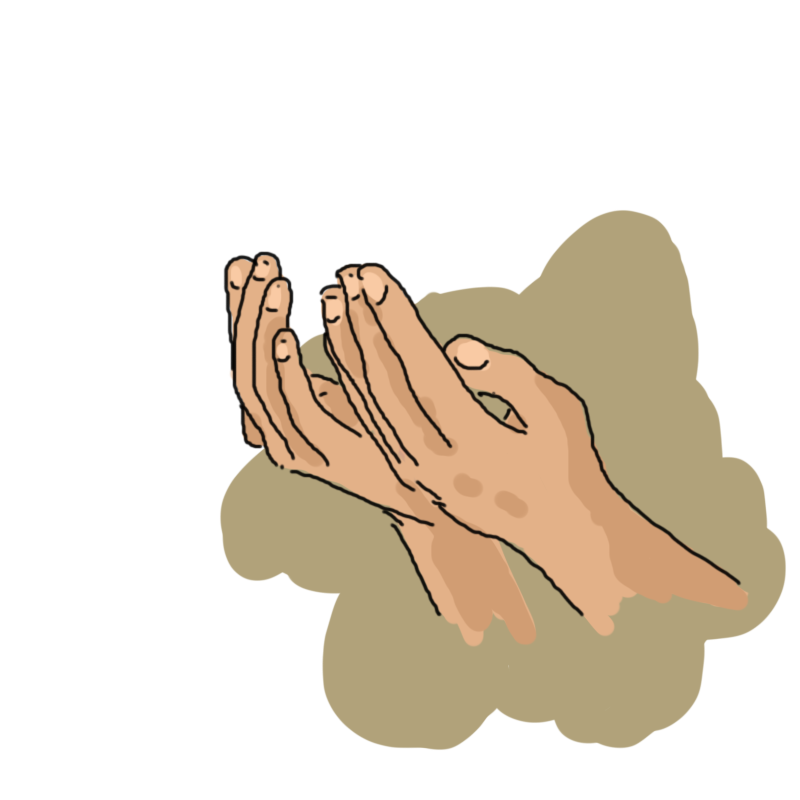
The Ahmadis had gathered to worship God that day in congregational prayer. Instead, they found shelter in the corner of a back room, lying on top of each other, their tongues repeating prayers.
Then, there was a loud bang in the hall. Ali remembers it being quiet—perhaps, his family told him this later, because his ears had gone numb from the sound of gunshots. The hall had turned yellow from the flying dust. To Ali, it looked like a sandstorm. He watched as some Ahmadis rushed to a cupboard at the back, flinging out informational magazines printed by AMJ. These magazines, typically treated with the utmost care, were now tossed aside—there was no time for reverence. They pulled out a hammer stored for emergencies and began breaking the wall behind the cupboard in the heat of desperation. Ali remembers that punches and kicks were thrown, too. Once the wall was taken down, all the Ahmadis in the room, starting with the children, squeezed through the hole in the wall and into the street, and where they took shelter in a nearby Ahmadi home. Ali’s father pushed him through the hole haphazardly, accidentally cutting his face in the attempt. But he landed otherwise safely on the other side, atop bricks from the building and the magazines which had been strewn.
As the Ahmadis ran into the home for shelter, Ali remembers the chaos. He watched a distant family member walk to a bed in the home, his shirt lifted, and the red hole at the center of their stomach created by flying shrapnel. Ali began to cry, although he didn’t know exactly why. But in true Ahmadi fashion, those around him became a source of support, young and old alike, comforting each other as they sat praying patiently in the face of violence.
Meanwhile, on the mosque grounds, grenades had been thrown by the terrorist. The first was thrown into the street, the second landed on a metal water cooler, sending shrapnel across the lawn and injuring Ahmadis still surrounding the area. The last grenade never exploded by “God’s grace,” Ali says. After a short gunfight with the young Ahmadis guarding the mosque, the terrorist launched a final grenade to take his own life.
One Ahmadi was martyred as a result of the attack while attempting to fend off the assailant, but the rest survived. For Ali, who had earlier that day been most concerned about his video game, the attack shaped what it meant to be an Ahmadi in Pakistan: living under the constant threat of grave danger, but with an unwavering trust in God.
Religious Persecution Migrates
One of the many problems with persecution is its ability to migrate across borders. Amarnath Amarasingam, associate professor of religion at Queen’s University, says it’s unsurprising that people bring their prejudices with them as they travel between countries. In cases like Pakistan’s, where discrimination against Ahmadis is enshrined in the law and considered more legal than it is a social attitude, it’s easier for the prejudice to permeate and spread.
In Canada, Ahmadis proudly identify as Muslims. They lead many discussions on Islam, surrounding topics such as Islamic Heritage Month or the Muslims for Remembrance campaign, which takes place every November 11. Here, many have also sought refuge from persecution.
Choudhry quantifies the Ahmadi population in Canada at around 40,000. Thousands of members of the community here are connected to someone who was martyred for their faith elsewhere in the world. But as much as Canada has become a haven of religious freedom for Ahmadis, remnants of anti-Ahmadiyyat exist in some of the non-Ahmadi Pakistani diaspora communities.
“It’s the fact that Ahmadis claim to be included in the Muslim community that some take issue with,” Amarasingam says. “Even if it isn’t active discrimination in Canada, although that exists, there is this kind of unspoken sense of, ‘They’re not really part of us.’”
Many Ahmadis in Canada have successfully established themselves in the country. Among them are people like Bilal*, who has been working in the halal meat industry for over fifteen years. In 2016, Bilal decided to open his own halal grocery store in Mississauga. He acquired an existing business that was already in operation and improved it before reopening. In the same plaza as his store, there was a local mosque that belonged to Muslims of a different sect of Islam. One day, the head of the mosque announced that the Muslims should not give any business to the Ahmadi (or rather, Mirzai) store which had opened in the area. Sales at Bilal’s store began to decline slowly, but later, the business incurred such a financial loss that it had to close. “It’s quite similar to our businesses being closed in Pakistan,” he says. Even in that moment, as he saw the discrimination follow him across the border, he said his trust in God did not waver.
Bilal’s experience is not a one-off case of Canada’s growing anti-Ahmadi sentiment. Some Ahmadi students, as young as elementary school age, report being confronted by their peers about their identity: “What kind of Muslim are you?” they are asked. After learning that they are Ahmadi, some immediately seek to distance themselves, claiming that Ahmadis should not be befriended. Whether the sentiment comes from learned behaviour from their parents or anti-Ahmadi sentiment on social media, Canada’s anti-Ahmadi attitude is, at least in part, home-grown.
Still, it is Pakistan’s law that excludes Ahmadis; the belief that they are not Muslim has crossed borders. “If you’re a diehard believer, even outside the blasphemy laws, that the Ahmadiyya community isn’t part of the Muslim community at large,” says Amarasingam, “you’re going to put that into practice whenever you see any sort of advancement with the Ahmadis.”
These Ahmadis, even the young ones, hold firm to their beliefs, no matter the loss of friends, money, or life. For some Ahmadis, every act of persecution or violence allows them to double down on prayer and grow closer to their faith.
Anti-Ahmadiyyat in Canada
I am a born Ahmadi, a few generations down in a line of devout believers. The first time I was properly confronted with the persecution of my people was in 2020, when I joined Twitter (now X). Before then, I’d only heard accounts of persecution from my family. I knew there was opposition to our beliefs. But those stories of cruel-hearted discrimination and acts of violence sounded so distant—sepia-toned tales of a different era, far removed from my digital age. Against all odds, it was Twitter that set reality in place.
In my X bio, I proudly display that I am an Ahmadi Muslim, which could explain why it didn’t take long for the anti-Ahmadi trolls to find me. Their hate quickly flooded every post I made, whether it was related to Ahmadiyyat or not. The notification counter would tick up with news of vile public comments and quote re-tweets. First, derogatory terms directed at me—curse words of all kinds, many that I’d never heard before, some in Urdu that I had to put through a translator just to understand. They cursed my parents and my lineage for having chosen to accept Islam Ahmadiyyat. They called us apostates, implying we’ve disaffiliated with Islam. They even photoshopped respected figures of my faith into indescribable, repulsive situations that made my heart seize. But, even in Canada, internet hate comments are far from the worst forms of abuse Ahmadis face.
Here, the Ahmadiyya community garnered headlines when it faced what many said were Islamophobic attacks against its annual Islamic Heritage Month event. In the Tahir Hall Community Centre in Vaughan, Ontario, the community had organized a large-scale exhibition of the various contributions Muslims made to the world. They invited local schools to bring their classes on a field trip to the community centre in the spirit of learning. However, a backlash over social media, which quickly amassed thousands of views, accused the community of trying to indoctrinate children by including the recitation of the Quran at the start of their event. Here, in addition to the anti-Ahmadiyyat, Ahmadi Muslims must grapple with Islamophobia too.
“It’s a sack of weights over every heart when an Ahmadi anywhere is punished for their faith.”
In 2021, the Afzaals, a Muslim family in London, Ontario, were murdered in a horrific and senseless pick-up truck attack. The killer, Nathaniel Veltman, was convicted, and a judge had called his crime a “textbook” case of terrorism. When Muslims across the country united in grief and prayer, Ahmadis were right there on the front line—the community’s motto, “Love for All, Hatred for None,” was displayed on blue placards at multiple memorials, vigils, and marches.
At a time of such tragedy, though, some couldn’t help but think: what if the Afzaal family had been Ahmadi? Junaid Jahangir, an associate professor at MacEwan University wrote in a column that the Pakistani community, in Canada and outside of it, rallied in support of the family brutally slain. But he asks, if this family had been Ahmadi Muslim, “Would there have been large prayer gatherings across Canada for them? Would Canadian Muslim institutions have been actively involved in calling out government institutions for more protection against Islamophobia? Or would they have side-lined or minimized the incident with ifs and buts?”
Pakistan’s then-human rights minister, Shireen Mazari, condemned the murder of the Afzaal family, commenting on how “intolerance and hate for ‘the other’ is becoming endemic across the globe.” On the same day as the London attack, a funeral procession held for an Ahmadi man in Pakistan was attacked by an extremist mob. Ironically, Mazari had no comment on the state of human rights then. Her silence was a deafening indicator of the value Ahmadi Muslim lives have compared to mainstream Muslims.
Muslims in Canada, across sects, make up almost five per cent of the Canadian population. Irrespective of sect, they are on the receiving end of physical, online and systemic abuses. A recent report from the House of Commons noted that a “new wave of Islamophobia has emerged within a broader context of rising hate towards several minority groups.” But even if those internal strifes remain, AMJ Canada is still always seeking to make changes for the betterment of all Muslims in the country. Their spokesperson Asif Khan was one of the many witnesses to testify in the House of Commons report, making recommendations for the advancement of peace, unity, and understanding above all. It’s a moral they are taught by Islam and a principle they preach for the sake of God and humanity.
Where Do We Go From Here?
In Canada, many Ahmadis find peace in the ability to freely practice their faith, even though the suffering of the community persists elsewhere. Even though Canadian Ahmadis are not arrested for their faith here, their parents, siblings, friends, neighbours, and family are still at risk of being jailed in Pakistan and other parts of the world. It’s a sack of weights over every heart when an Ahmadi anywhere is punished for their faith. The persecution of Ahmadi Muslims is not classical lore from a black-and-white era. It’s as present as ever, alive in our pixelated age. It’s normalized, state-sanctioned, taught, and practiced.
Choudhry says that once the state becomes complicit in and normalizes the persecution of any group, whether they be Ahmadis or anyone else, it has ventured down a path of no return. In Pakistan, the anti-Ahmadi prosecution has become clear: those who stand up to it, even those with influence, are killed. As stated by Shaan Taseer, the son of a former governor of Punjab who was murdered for “blasphemy,” the law is off the books—the average Pakistani has taken it into their hands.
Organizations like Amnesty International, Human Rights Watch and the US Commission on International Religious Freedom have all recognized the suffering of Ahmadis in places around the world, particularly in Pakistan. They have recognized the role of the state and law enforcement in enabling persecution to occur. Ahmadis describe the situation in Pakistan as apartheid. Hamdani goes as far as to call it a cultural, religious, and physical genocide. And yet, for the attention it receives from organizations, little is done to stem the violence itself.
For Ahmadis, that’s not unexpected. Ali, Choudhry, Sidhu, Bilal, and many other Ahmadis around the world have the same response to the persecution their community faces: they don’t anticipate anything from governments or organizations, especially not those that are complicit. Riots, protests, or reciprocal violence won’t achieve anything meaningful. Many systems have failed. Their only expectation is that God delivers justice.
They still hope that one day, Pakistan will heal and forsake its resentment. That its non-Ahmadi people will take charge to defend the rights of all minorities in the country. For all the violence it has shown them, Ahmadi Muslims still believe that love of country is part of faith. They pray their country will veer off its path of destruction and soon love them back.
Hamdani, a non-Ahmadi, says as much as his heart hurts at the failure of Jinnah’s vision for a secular Pakistan, he cannot help but be in awe of the Ahmadiyya community. “There has to be some kind of extraordinary relationship that you have with God,” he says, “because if someone else was in your shoes, they would probably be questioning His existence.”
Ahmadis say they have no reason to question God’s existence. Their tear-stained prayer mats, their tight community spanning across borders, their Caliph that unites and divinely guides them, and their continued growth are all the proof they need. In the midst of violence, the belief that a higher power has their back keeps them going. They boldly proclaim their Ahmadi Muslim faith, with heads held high, even if the tip of a knife is held to their necks. If any state wants to punish them for that, God will be the one to answer.

